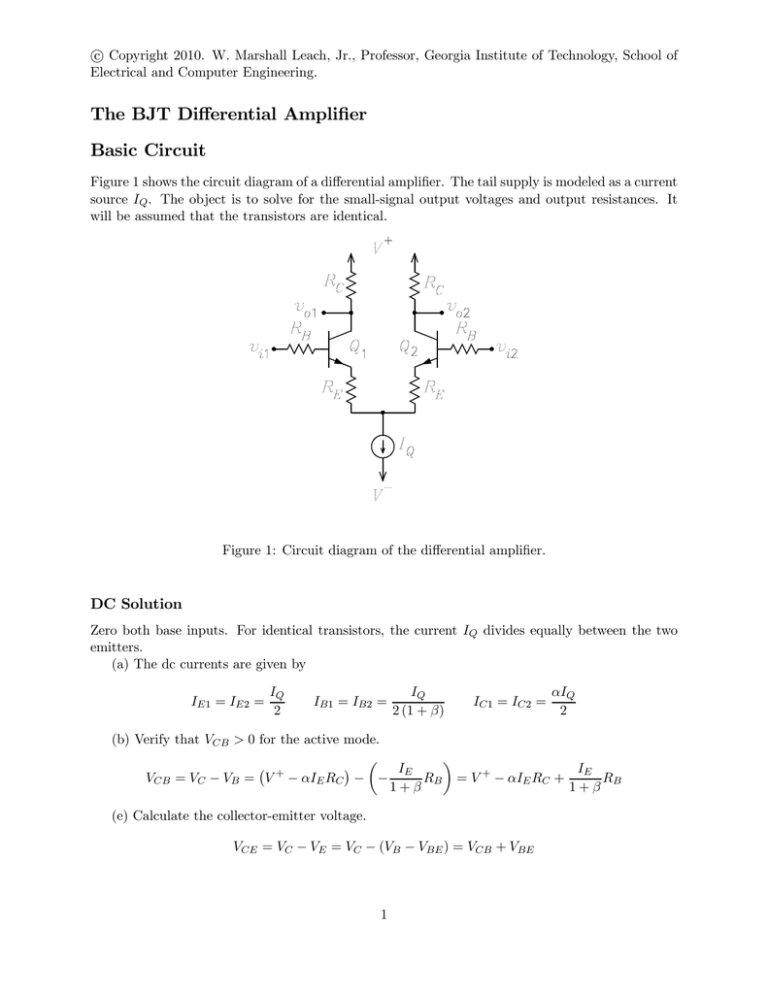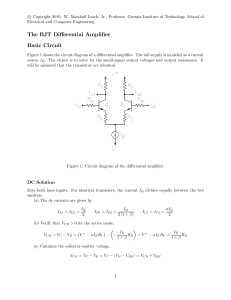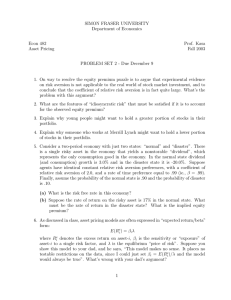The BJT Differential Amplifier Basic Circuit
advertisement

c Copyright 2010. W. Marshall Leach, Jr., Professor, Georgia Institute of Technology, School of ° Electrical and Computer Engineering. The BJT Differential Amplifier Basic Circuit Figure 1 shows the circuit diagram of a differential amplifier. The tail supply is modeled as a current source IQ . The object is to solve for the small-signal output voltages and output resistances. It will be assumed that the transistors are identical. Figure 1: Circuit diagram of the differential amplifier. DC Solution Zero both base inputs. For identical transistors, the current IQ divides equally between the two emitters. (a) The dc currents are given by IE1 = IE2 = IQ 2 IB1 = IB2 = IQ 2 (1 + β) IC1 = IC2 = αIQ 2 (b) Verify that VCB > 0 for the active mode. ¶ µ ¡ ¢ IE IE RB = V + − αIE RC + RB VCB = VC − VB = V + − αIE RC − − 1+β 1+β (e) Calculate the collector-emitter voltage. VCE = VC − VE = VC − (VB − VBE ) = VCB + VBE 1 Small-Signal AC Solution using the Emitter Equivalent Circuit This solution uses the r0 approximations and assumes that the base spreading resistance rx is not zero. (a) Calculate gm , rπ , re , and rie . gm = IC VT rπ = VT IB re = VT IE rie = RB + rx + rπ 1+β r0 = VA + VCE IE (b) Redraw the circuit with V + = V − = 0. Replace the two BJTs with the emitter equivalent circuit. The emitter part of the circuit obtained is shown in Fig. 2(a). Figure 2: (a) Emitter equivalent circuit for ie1 and ie2 . (b) Collector equivalent circuits. (c) Using Ohm’s Law, solve for ie1 and ie2 . ie1 = vi1 − vi2 2 (rie + RE ) ie2 = −ie1 (d) The circuit for vo1 , vo2 , and rout is shown in Fig. 2(b). vo1 = −ic1(sc) × ric kRC = −α × ie1 × ric kRC = −α × ric kRC (vi1 − vi2 ) 2 (rie + RE ) vo2 = −ic2(sc) × ric kRC = −α × iie2 × ric kRC = −α × ric kRC (vi2 − vi1 ) 2 (rie + RE ) rout1 = rout2 = ric kRC ¸ β (2RE + rie ) + (RB + rx + rπ ) k (2RE + rie ) RB + rπ + rx + 2RE + rie (e) The resistance seen looking into either input with the other input zeroed is · ric = r0 1 + rin = RB + rx + rπ + (1 + β) (2RE + rie ) The differential input resistance rind is the resistance between the two inputs for differential input signals. For an ideal current source tail supply, this is the same as the input resistance rin above. Diff Amp with Non-Perfect Tail Supply Fig. 3 shows the circuit diagram of a differential amplifier. The tail supply is modeled as a current 0 having a parallel resistance R . In the case of an ideal current source, R is an open source IQ Q Q 0 = 0. The solutions circuit. Often a diff amp is designed with a resistive tail supply. In this case, IQ below are valid for each of these connections. The object is to solve for the small-signal output voltages and output resistances. 2 Figure 3: BJT Differential amplifier. DC Solutions 0 is known. If I is known, the solutions are the same as above. This solution assumes that IQ Q (a) Zero both inputs. Divide the tail supply into two equal parallel current sources having a 0 /2 in parallel with a resistor 2R . The circuit obtained for Q is shown on the left in current IQ 1 Q Fig. 4. The circuit for Q2 is identical. Now make a Thévenin equivalent as shown in on the right in Fig. 4. This is the basic bias circuit. (b) Make an “educated guess” for VBE . Write the loop equation between the ground node to the left of RB and V − . To solve for IE , this equation is ¢ ¡ IE 0 RB + VBE + IE (RE + 2RQ ) RQ = 0 − V − − IQ 1+β (c) Solve the loop equation for the currents. IE = 0 R −V −V − + IQ Q BE IC = (1 + β) IB = α RB / (1 + β) + RE + 2RQ (d) Verify that VCB > 0 for the active mode. ¶ µ ¡ + ¢ IE IE RB = V + − αIE RC + RB VCB = VC − VB = V − αIE RC − − 1+β 1+β (e) Calculate the collector-emitter voltage. VCE = VC − VE = VC − (VB − VBE ) = VCB + VBE 0 /2. If the current source is replaced with a resistor (f) If RQ = ∞, it follows that IE1 = IE2 = IQ RQ only, the currents are given by IE = IC −V − − VBE = (1 + β) IB = α RB / (1 + β) + RE + 2RQ 3 Figure 4: DC bias circuits for Q1 . Small-Signal or AC Solutions This solutions use the r0 approximations. (a) Calculate gm , rπ , and rie . gm = αIE VT rπ = (1 + β) VT IE rie = RB + rx + rπ 1+β r0 = VA + VCE αIE 0 = 0. Replace the two BJTs with the emitter (b) Redraw the circuit with V + = V − = 0 and IQ equivalent circuit. The emitter part of the circuit obtained is shown in 5(a). Figure 5: (a) Emitter equivalent circuit. (b) Collector equivalent circuits. (c) Using superposition, Ohm’s Law, and current division, solve for ie1 and ie2 . ie1 = RQ vi2 vi1 − × rie + RE + RQ k (rie + RE ) rie + RE + RQ k (rie + RE ) RQ + rie + RE 4 ie2 = RQ vi1 vi2 − × rie + RE + RQ k (rie + RE ) rie + RE + RQ k (rie + RE ) RQ + rie + RE For RQ = ∞, these become ie1 = vi1 − vi2 2 (rie + RE ) ie2 = vi2 − vi1 2 (rie + RE ) (d) The circuit for vo1 , vo2 , rout1 , and rout2 is shown in Fig. 6. Figure 6: Circuits for calculating vo1 , vo2 , rout1 , and rout2 . vo1 = −i0c1 −α × ric kRC × ric kRC = −α × ie1 × ric kRC = rie + RE + RQ k (rie + RE ) vo2 = −i0c2 −α × ric kRC × ric kRC = −α × ie1 × ric kRC = rie + RE + RQ k (rie + RE ) · ric = r0 1 + ¸ µ vi1 − vi2 µ vi2 − vi1 RQ RQ + rie + RE RQ RQ + rie + RE ¶ ¶ rout1 = rout2 = ric kRC βRte + (RB + rx + rπ ) kRte RB + rπ + Rte Rte = RE + RQ k (rie + RE ) (e) The resistance seen looking into the vi1 (vi2 ) input with vi2 = 0 (vi1 = 0) is rib = RB + rx + rπ + (1 + β) Rte (f) Special case for RQ = ∞. vo1 = −α × ric kRC (vi1 − vi2 ) 2 (rie + RE ) vo2 = −α × ric kRC (vi2 − vi1 ) 2 (rie + RE ) (g) The equivalent circuit seen looking into the two inputs is shown in Fig. 7. The resistors labeled rπ0 are given by rπ0 = rx + rπ + (1 + β) RE The differential input resistance rid is defined the same way that it is defined for Fig. ??. That is, it is the resistance seen between the two inputs when vi1 = vid /2 and vi2 = −vid /2, where vid is the differential input voltage. In this case, the small-signal voltage at the upper node of the resistor (1 + β) RQ is zero so that no current flows it. It follows that rid is given by ¡ ¢ rid = 2 RB + rπ0 5 Figure 7: Equivalent circuits for calculating ib1 and ib2 . Differential and Common-Mode Gains (a) Define the common-mode and differential input voltages as follows: vid = vi1 − vi2 vicm = vi1 + vi2 2 With these definitions, vi1 and vi2 can be written vi1 = vicm + vid 2 vi2 = vicm − vid 2 By linearity, it follows that superposition of vicm and vid can be used to solve for the currents and voltages. (b) Redraw the emitter equivalent circuit as shown in Fig. 8. Figure 8: Emitter equivalent circuit. (c) For vi1 = vid /2 and vi2 = −vid /2, it follows by superposition that va = 0 and ie1 = vid /2 rie + RE ie2 = −vid /2 rie + RE vo1 −α × ric kRC −α × ric kRC vid = = −α × ie1 × ric kRC = rie + RE 2 rie + RE vo2 +α × ric kRC +α × ric kRC vid = = −α × ie2 × ric kRC = rie + RE 2 rie + RE 6 µ µ vi1 − vi2 2 vi1 − vi2 2 ¶ ¶ The differential voltage gain is given by Ad = vo1 vo2 1 αric kRC =− =− vid vid 2 rie + RE (d) For vi1 = vi2 = vicm , it follows by superposition that ia = 0 and ie1 = vicm rie + RE + 2RQ ie2 = vicm rie + RE + 2RQ vo1 −α × ric kRC −α × ric kRC = −α × ie1 × ric kRC = vicm = rie + RE + 2RQ rie + RE + 2RQ vo2 −α × ric kRC −α × ric kRC = −α × ie2 × ric kRC = vicm = rie + RE + 2RQ rie + RE + 2RQ µ µ vi1 + vi2 2 vi1 + vi2 2 ¶ ¶ The common-mode voltage gain is given by Acm = vo1 vo2 α × ric kRC = =− vicm vicm rie + RE + 2RQ (e) If the output is taken from the collector of Q1 or Q2 , the common-mode rejection ratio is given by ¯ ¯ ¯ ¯ ¯ vo1 /vid ¯ ¯ vo2 /vid ¯ 1 rie + RE + 2RQ RQ 1 ¯=¯ ¯= = + CM RR = ¯¯ vo1 /vicm ¯ ¯ vo2 /vicm ¯ 2 rie + RE 2 rie + RE This can be expressed in dB. CM RRdB = 20 log µ RQ 1 + 2 rie + RE ¶ 0 = 2 mA, R = 50 kΩ, R = 1 kΩ, R = 100 Ω, R = 10 kΩ, V + = 20 V, Example 1 For IQ Q B E C V − = −20 V, VT = 0.025 V, rx = 20 Ω, β = 99, VBE = 0.65 V, and VA = 50 V, calculate vo1 , vo2 , vod , rout , and CM RR. Solution. IE = VCB ´ ³ 0 R 0 − V − − IQ Q − VBE = 1.192 mA RB / (1 + β) + RE + 2RQ µ ¶ ¢ ¡ + IE RB = 8.209 V = VC − VB = V − αIE RC − − 1+β αIE (1 + β) VT = 0.0472 S rπ = = 2.097 kΩ VT IE VT RB + rx + re = 31.17 Ω = 20.97 Ω rie = re = IE 1+β gm = VA + VCE = 49.869 kΩ Rte = RE + RQ k (rie + RE ) = 230.83 Ω IC · ¸ β (2RE + rie ) + (RB + rπ ) k (2RE + rie ) = 390.5 kΩ ric = r0 1 + RB + rπ + 2RE + rie µ ¶ RQ −α × ric kRC vi1 − vi2 = = −36.84vi1 + 36.75vi2 rie + RE + RQ k (rie + RE ) RQ + rie + RE r0 = vo1 vo2 = −36.84vi2 + 36.75vi1 7 rout = ric kRC = 9.75 kΩ Avd = − 1 α × ric kRC = −36.80 2 rie + RE −α × ric kRC = −0.0964 rie + RE + 2RQ ¯ ¯ ¯ Avd ¯ ¯ = 51.63 dB CM RRdB = 20 log ¯¯ Avcm ¯ Avcm = The Diff Amp with an Active Load Figure 9 shows a BJT diff amp with an active load formed by a current mirror with base current compensation. Similar circuits are commonly seen as the input stages of operational amplifiers and audio amplifiers. The object is to solve for the open-circuit output voltage voc , the short-circuit output current isc , and the output resistance rout . By Thévenin’s theorem, these are related by the equation voc = isc rout . It will be assumed that the current mirror consisting of transistors Q3 − Q5 is perfect so that its output current is equal to its input current, i.e. ic4 = ic1 . In addition, the r0 approximations will be used in solving for the currents. That is, the Early effect will be neglected except in solving for rout . For the bias solution, it will be assumed that the tail bias current IQ splits equally between Q1 and Q2 so that IE1 = IE2 = IQ /2. Figure 9: Diff amp with active current-mirror load. Because the tail supply is assumed to be a current source, the common-mode gain of the circuit is zero when the r0 approximations are used. In this case, it can be assumed that the two input signals are pure differential signals that can be written vi1 = vid /2 and vi2 = −vid /2. For differential input signals, it follows by symmetry that the signal voltage is zero at the node above the tail current 8 supply IQ . Following the analysis above, the small-signal collector currents in Q1 and Q2 are given by vid vid α α ic2(sc) = − ic1(sc) = rie + RE 2 rie + RE 2 where rie = RB + rπ 1+β The short-circuit output current is given by isc = ic4 − ic2 With ic4 = ic3 = ic1 and ic2 = −ic1 , this becomes isc = 2ic1(sc) = α α vid = (vi1 − vi2 ) rie + RE rie + RE The output resistance is given by rout = r04 kric2 where ric2 is given by ric2 · = r0 1 + ¸ β (2RE + rie ) + (RB + rπ ) k (2RE + rie ) RB + rπ + 2RE + rie By Thévenin’s theorem, the small-signal open-circuit output voltage is given by voc = isc rout = α (r04 kric2 ) (vi1 − vi2 ) rie + RE Example 2 For IQ = 2 mA, RB = 100 Ω, RE = 51 Ω, V + = 15 V, V − = −15 V, VT = 0.025 V, rx = 50 Ω, β = 99, α = 0.99 VBE1 = VBE2 = 0.65 V, VEB3 = VEB4 = VEB5 = 0.65 V, VC2 = VC4 = 13.7 V, and VA = 50 V, calculate isc , rout , and voc . Because rx > 0, we add it to RB in the equations above. Solution. re1 = re2 = 2VT = 25 Ω IQ Rte2 = 2RE + rie1 = 128.5 Ω r02 = VA + (VC2 + VBE ) = 65 kΩ αIQ /2 r04 = ric2 rie1 = rie2 = RB + rx + re = 26.5 Ω 1+β α (vi1 − vi2 ) = 0.0128 (vi1 − vi2 ) rie + RE · ¸ βRte + (RB + rπ ) kRte = 362.7 kΩ = r0 1 + RB + rπ + Rte isc = VA + (V + − VC4 ) = 51.82 kΩ IQ rout = r04 kric2 = 45.34 kΩ voc = isc rout = 579.2 (vi1 − vi2 ) This is a dB gain of 55.3 dB. 9









